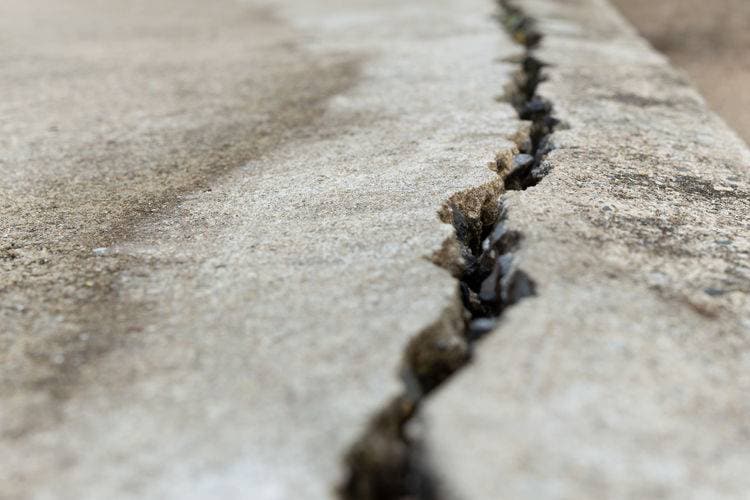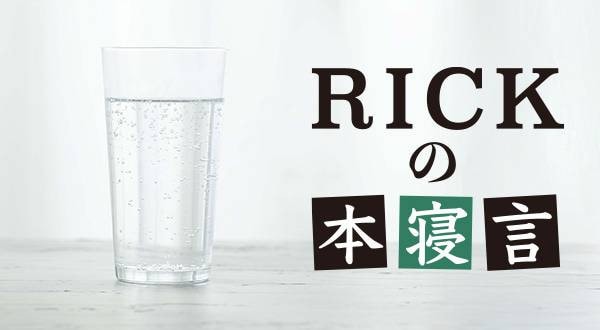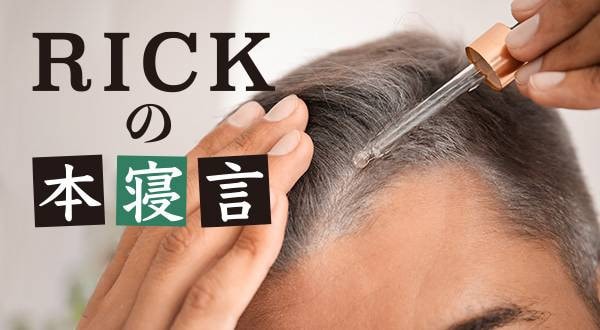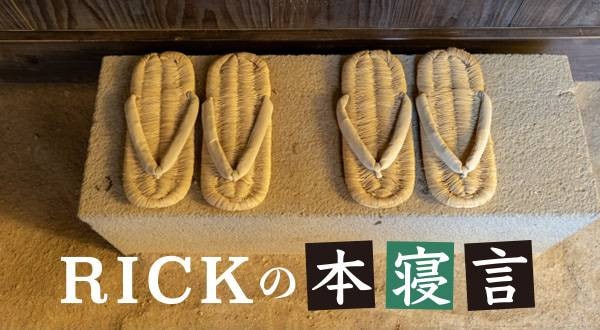The rainy season is dreary and depressing. It has already been declared over in Okinawa, but I wonder when it will be over in Kanto and Tohoku. This year’s rainy season, however, is not always a damp one, but rather a repetition of abnormal weather events, such as torrential rains caused by the development of a linear precipitation zone, which suddenly turns into a heat wave on a midsummer’s day. Although I prefer extremely hot weather to extremely cold weather, there has been so much damage from disasters that I can only pray for the safety of the residents in the affected areas.
Speaking of the rainy season, leaky roofs are a concern. For some reason, at Sound House, I, as the owner, have been in charge of leak prevention since the very beginning. Why is that? Moreover, this slightly grueling job is a repetitive, solitary task that I do almost all by myself. Employees have no way of knowing how hard it is, but I think it's time for someone to help me. This is because hard labor is always required in fixing leaks.
Why does Sound House leak so much in the first place? The answer is simple: The basic, fundamental cause is that they are used properties, i.e., battered warehouses and buildings bought at a big discount. It is a well-known fact that as buildings get older, they are more prone to leaks. Also, poor construction techniques, shoddy work, poor contractor skills, and lack of proper waterproofing measures are also causes of leaks. We have seen many instances of shoddy workmanship.
However, for some reason, the buildings around us seem to leak more often than most used buildings. A case in point is the warehouse addition in Tokushima, Japan that was completed two years ago. Despite the fact that a new addition was added right next to the warehouse, it was confirmed that it was not properly waterproofed at the connection, or expansion, and leaks occurred frequently. Even newly built buildings get hit! This is exactly the kind of leaky roof problem that comes up every year, to the point where we can only assume that it is haunted by some kind of leaky roof spirit.
Recently, the former Onagawa Junior High School, which we purchased a year and a half ago, was badly damaged by the flooding. The school building sits on a hill in the town that was directly hit by the earthquake 12 years ago, and frankly I am amazed that it survived the disaster. The former Onagawa Junior High School and Onagawa Elementary School are the only buildings on the hill that were not damaged by the earthquake, and we intend to preserve them as memorial buildings.
However, the scars of the earthquake were etched into the building in many places, even in places that aren't visible. As a result, whenever it rained, many corridors and rooms in the old school building were flooded with water, and the humidity was so severe that mold grew everywhere on the walls. To counter these problems, the expert in dealing with roof leaks (that's me) steps in.
I immediately went up to the rooftop of the badly leaking one-story portion of the building, and it turned out to be a pool-like pond. Even though there were signs of previous attempts at waterproofing, the entire rooftop was covered with a thick plastic tarpaulin, which should have prevented water leakage. However, I soon discovered loads of problems. First, I confirmed that water had accumulated to the point where it exceeded the raised edge of the tarp, and that water was entering through the sealing treatment that had been cut off at the connection. However, that alone was not the cause of the leaks. There must surely be a hole or crack somewhere in the original rooftop area underneath, so I decided to take the plunge and remove the entire tarp by myself.
This is really hard work. First of all, this thick sheet is heavy, probably about 10m x 20m. The heavy sheet is tightly joined to prevent water leakage, so it is cut into 1-meter-wide strips with a cutter knife. Then I cut it into 5m pieces, rolled it upl, lifted it up and carried it. The problem was that it was dirty. Water dripped from the edges and seeped in, eventually collecting under the tarp of the entire rooftop, which, by the way, was full of insects. I witnessed a sight so unpleasant that there is no way to explain it! This was nothing short of an endurance contest because I had to just to suck it up and peel off the tarp and roll it up.
When I stripped it all off and examined the rooftop, I found the cause of the leak in one shot. First of all, the sealing material, or in other words, the material that fills in the gaps where the building wall meets the roof, had broken here and there, allowing water to drip through these small gaps. Moreover, there were many areas that were not sealed at all. This was a clear indication of shoddy work. Normally, the gaps would have been sealed before the tarpaulin was put up, but the contractor did not seal the gaps because the tarpaulin was put up first. This allowed rainwater to seep in and cause leaks.
Another problem is the drains, specifically the steel fittings at the entrance to the drains. I found that not only were these rusted, but they also had holes that had formed between the drain fittings and the building frame. Then, when water began to pool, water would leak from there along the wall. Therefore, my job was not only to fill in the gaps with sealant to prevent water from leaking, but also to tightly seal the gaps around the drains to prevent water from entering the building. By doing this, I was able to prevent 98% of the leaks, but it was a strenuous task.
Let me give you another example. Heading west, there is a large warehouse in Tokushima that was designed to prevent leaks. That one could be called more of a waterfall flood control measure than a leak because it had been known for some time that whenever it rained, the floor of the 150-meter-long warehouse would be soaked by the large amount of water falling from the ceiling in a span of about 20 meters along the centerline of the large warehouse. This gradually worsened, and one day during a heavy rainstorm, a 10-meter-wide waterfall-like wall of water formed inside the warehouse, even though it was indoors. I was surprised, but there was nothing I could do about it.
The cause of this leak was immediately apparent. The roof of the gabled roof has a drain for rainwater at the pointed centerline of the roof, but the drain had apparently stopped flowing, and the water overflowing from the drain flowed to the left and right and fell down like a waterfall to the floor 12 meters below. The only solution was to go up to the rooftop and clean the very long rainwater drain, which could be as long as 100 meters.
I immediately went up to the roof to check the drain, and sure enough, it was clogged with mud that had accumulated like sludge. This is where the hard work began. The drain was covered with a stainless steel cover like a roof, and there was only a narrow gap that could fit a single nail. So, although it was tedious, I had to use a small shovel to fill the bucket with mud little by little. This process went on for hours. It was the beginning of an endless battle, and honestly it was tiresome. The work was done on a 12-meter-high rooftop slope, and this was not a job for those who are afraid of heights. Moreover, the work involved pumping out lots of sludge. The sludge was placed in buckets, and once the buckets were full, the workers walked to the edge of the roof and dumped the sludge down from the rooftop. This is actually the scariest part of the job. I had to walk to the edge of the roof without ropes and swing the bucket from a height of nearly 10 meters to dump the mud. As one might expect, I felt intimidated on many occasions. Therefore, I was the only one who could do this job, and I never allowed other staff members to do it.
Cleaning with a shovel, however, has its limitations and can only clean the area to a certain extent. In some places, it was found that there were areas that could not be reached, and water would eventually accumulate there. This is where the high-pressure washer comes in. For this rooftop drain cleaning, I had prepared a powerful high-pressure washer for professional use. However, two problems related to voltage and water pressure arose. First, it was a large warehouse, 12 m high and 150 m long, and even if electricity was to be pulled in by a power cord, about five units of 30 m reel-type extension cords would have to be connected. Naturally, this would cause a voltage drop, and the high-voltage cleaners would not work. Therefore, after considering the shortest possible distance, we pulled the extension cords across from a nearby company outlet and managed to connect three units so that the high-voltage cleaners would work.
Another problem is water pressure. Normally, a hose is connected to a water tap to pull water, but the recommended distance is only about 30 meters. However, if the water is pulled for 100m, the water pressure will be reduced and the water from the high-pressure cleaner will not come out as easily. Again, as a desperate measure, we found the shortest route ourselves and connected three 30-meter hoses, which barely produced water. This was the hardest part. After that, it was just a matter of using a high-pressure washer to spray the drain with increasingly strong showers of water to clean it up. After some time, the drain was finally sparkling clean. Now the water is flowing and will not overflow from the end of the drain. In other words, we were sure that the leak would stop.
At any rate, the misfortune of leaking roofs comes in endlessly. At the former Onagawa Junior High School mentioned above, as a result of the great earthquake, it was discovered that not only the roof, but also the wall frames were cracked everywhere, and when it rained, water seeped into the building through these cracks. The very scars of the earthquake were initially unnoticed. The only way to repair the damage was to call in a contractor to not only locate and seal the cracks from outside, but also to waterproof and paint the entire wall surface. In addition, the headquarters in Narita, a luxurious and seemingly the most powerful building in Japan, has been experiencing a series of leaks recently, and the cause is still unknown. This is a problem. The building we purchased more than 20 years ago, known as Narita's new building, has been so neglected with leaks from the roof that the ceiling is now covered with mold and has become a serious problem. Such battles with leaks are too numerous to enumerate.
Sometimes when I think of my job as a leak prevention specialist, I suddenly wonder, "What the hell am I doing!" However, this is also my responsibility as the founder of the company. I call myself the "Iron man of leak prevention" to inspire myself.


































